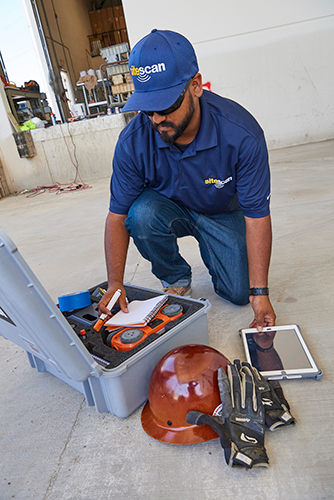Neighborhood RainierGPR Service Areas for Precision Concrete Scanning
Neighborhood RainierGPR Service Areas for Precision Concrete Scanning
Blog Article
Concrete Scanning: A Crucial Step In The Direction Of Making Certain Structural Honesty and Security
In the realm of construction and infrastructure upkeep, the relevance of concrete scanning can not be overstated. This thorough procedure holds the key to introducing possible dangers hidden under the surface area of relatively solid structures. By employing sophisticated modern technology and methodologies, concrete scanning serves as a critical tool in guaranteeing that the stability and safety of bridges and buildings are upheld to the greatest standards. Nonetheless, beyond its surface-level ramifications, the duty of concrete scanning prolongs much much deeper than meets the eye.
Relevance of Concrete Scanning
Concrete scanning plays a critical role in making sure the structural integrity and safety and security of buildings and framework projects. By utilizing innovative innovations such as ground-penetrating radar (GPR) and electro-magnetic induction, specialists can non-destructively inspect concrete structures to discover prospective problems, gaps, embedded items, and support design. This procedure enables very early discovery of anomalies that might compromise the stability of a framework, stopping costly damages and ensuring the security of residents.
Concrete scanning is specifically important during the preparation and construction stages of a project. Prior to boring, cutting, or coring right into concrete, scanning assists determine the accurate areas of rebar, post-tension cords, and various other embedded aspects, minimizing the risk of unintentional hits that can lead to architectural weak points. Furthermore, concrete scanning help in high quality control by verifying the thickness of concrete covers and discovering any discrepancies that might influence the general resilience of the framework. Eventually, purchasing concrete scanning services is not just a proactive measure to mitigate threats yet also an essential action towards keeping the long-term safety and security and security of buildings and facilities.
Modern Technology for Concrete Assessment

Benefits of Very Early Detection
Prompt discovery of structural issues can significantly reduce dangers and guarantee the longevity of building projects. By determining potential issues at an early stage in the building and construction procedure, stakeholders can take positive measures to attend to issues before they intensify right into bigger and a lot more expensive issues. One of the vital benefits of very early discovery is the avoidance of architectural failures, which can pose severe safety and security dangers and bring about job hold-ups and monetary losses.
Furthermore, early discovery enables prompt repair services and upkeep, which can assist extend the life-span of the structure. By addressing concerns quickly, building and construction groups can stay clear of expensive repairs and even the need for premature replacement of architectural components. This proactive technique not only saves time and cash yet likewise improves the general safety and security and durability of the construction task.
Furthermore, early detection can enhance task planning and decision-making by supplying stakeholders with important understandings right into the problem of the framework. Armed with this info, job supervisors look at here now can make informed selections relating to building and construction methods, timelines, and products, leading to extra efficient and effective project results.
Guaranteeing Structural Stability
Making sure the architectural security of a building and construction task is critical to its safety and security and longevity. Structural security refers to the capacity of a structure or facilities to keep its kind and feature under environmental problems and various tons. To accomplish this, complete analysis and monitoring of the framework are essential. Concrete scanning plays a vital function in ensuring structural stability by identifying possible concerns such as voids, delamination, or support corrosion that might compromise the integrity of the structure with time.
By utilizing sophisticated scanning innovations like ground-penetrating radar (GPR) and electro-magnetic induction, construction experts can non-invasively examine concrete structures to determine locations of concern below the surface area. This proactive approach enables the early detection of weak points or flaws, allowing timely repairs or reinforcement to stop structural failings.
Normal concrete scanning throughout different building phases and throughout the life cycle of a framework can assist preserve its security, minimize threats, and ensure the safety of owners. By prioritizing structural security via concrete scanning, building jobs can boost their durability and resilience, ultimately adding to higher safety and durability.
Protecting Against Crucial Failures
Carrying out routine evaluations, such as concrete scanning, can reveal hidden flaws like voids, splits, or rust that could endanger the integrity of a framework. By utilizing sophisticated scanning innovations like Ground Permeating Radar (GPR) or Concrete X-ray, engineers can non-destructively assess the condition of concrete and identify weak factors that call for support or repair service.

Conclusion
Finally, concrete scanning plays a crucial role in making certain structural stability and safety and security by utilizing innovative innovation for very early discovery of potential issues. This positive method aids prevent critical failures and makes certain the security of structures. It is vital to prioritize concrete assessment as a common technique to safeguard the durability and security of structures and framework.
Concrete scanning plays a critical function in guaranteeing the architectural honesty and security of structures and facilities projects. In addition, concrete scanning help in top quality control by verifying the density of concrete covers and spotting any kind of disparities that may impact the general toughness of the structure. Concrete scanning plays an essential role in guaranteeing architectural security by spotting potential problems such as voids, delamination, or support rust that could compromise the stability of the framework over time.

In final thought, concrete scanning plays a critical function in guaranteeing architectural stability and safety by using click reference innovative technology for very early detection of prospective problems.
Report this page